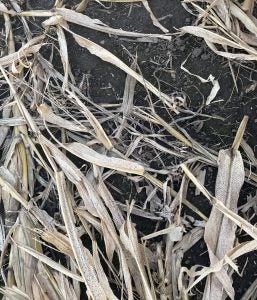Residue management is essential to remove tar spots from corn

The tar stain has spread over much of the corn belt, and although it arrived too late in 2022 to have a major impact for most farmers, farmers know that its spores can overwinter in corn residue. This has increased the focus on residue management, especially for corn-on-corn acres that are more prone to diseases such as tar spotsanthracnose and gray leaf spot.
Objectives of waste management
“Tar spot has become such a challenging and widespread disease,” comments Joe Stephan, an agronomist AgriGold and farmer in Indiana and Michigan. While AgriGold has some of the best tar spot tolerance products on the market, the germplasm pool has yet to deliver fully resistant products. “That means we also have to incorporate old ways of managing the disease, focused on breaking down the residues,” he says.
“When we talk about residue management, we’re trying to reduce the amount of pathogen that’s in that field that can impact the next crop,” Stephan explains. “I suspect there will be more corn acres in 2023, and some of that will come from corn after corn. When you’re in a continuous corn scenario, there’s a lot of residue for pathogens to live in, increasing the risk of disease the following season.
“We try to mitigate some of that with fungicides, but I think there’s a lot of wisdom in trying to reduce the residue that’s in the field,” he adds. Even if you do a good job of managing residues, Stephan notes that diseases can emerge from neighboring fields.
One of the most critical elements of residue management is achieving good soil-residue contact. Stephan explains, “This allows microbes and earthworms in the soil to break down the residues and pathogens it contains.”

Tools for waste management
“Putting waste in contact with the soil does not necessarily mean burying it,” according to Stephan. “Residue management could involve steps like using stalks on corn heads to push the residue down, or a light pass with a vertical tillage tool to make sure the stalk is down and in contact with the soil.”
More aggressive tillage, which buries residues deeply, is popular in some parts of the U.S. While Stephan says it’s good for breaking down residues, it also opens up the potential for erosion by wind or water. He advises those working harder to focus on less erodible land.
Other tools that can help include cutting the corn heads, which “chops up that residue and allows the leaves to make better contact with the soil,” Stephan says. “If a farmer uses a corn header, rotary mower or vertical tiller to help manage tar residue, he or she should make sure to follow it up in the spring with row cleaners to try to get as uniform an environment as possible for that seed. possible.
“Some also apply biologicals and stubble digesters to help break down residues or increase microbial activity,” he continues, adding, “Anything you can do to speed up or increase decomposition is good.”
Stephan is also an advocate of managing disease pressure with fungicides, especially for corn-on-corn acres. “Fungicides address two sides of the disease triangle, making a susceptible host less susceptible and, in some forms, reducing the amount of the pathogen,” he explains.
He encourages farmers to start planning, talking to agricultural retailers and making fungicide purchases for the 2023 growing season now. “The days of calling an agricultural retailer in July and saying you want to spray fungicide are over for now,” says Stephan.
Also, residue placement matters
Stephan has two philosophies when it comes to cultivating the soil. “One, you’re either aggressive and move the residue down below the main part of the root zone (0 to 4 inches deep) or two, you keep the residue very shallow, which is where vertical tillage comes in.”

He explains, “Putting residues in that band of the root zone can be problematic because those microbes will fight the corn plant for nitrogen. And the microbes will win.”
This battle for nitrogen is why Stephan is concerned that many farmers are jumping on the high-speed disc tillage bandwagon. “They drive fast and do a nice job, but they incorporate the corn residue right into the root zone,” he explains. “I fear that farmers could experience nitrogen deficiency on corn because the nutrients are used first by the bacteria.”
https://www.agdaily.com/crops/residue-management-is-critical-to-ward-off-tar-spot-in-corn/ Residue management is essential to remove tar spots from corn





.jpg?width=1200&enable=upscale)